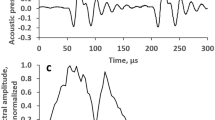Abstract
Forward masking was investigated by the auditory evoked potentials (AEP) method in a bottlenose dolphin Tursiops truncatus using stimulation by two successive acoustic pulses (the masker and test) projected from spatially separated sources. The positions of the two sound sources either coincided with or were symmetrical relative to the head axis at azimuths from 0 to ± 90°. AEPs were recorded either from the vertex or from the lateral head surface next to the auditory meatus. In the last case, the test source was ipsilateral to the recording side, whereas the masker source was either ipsi- or contralateral. For lateral recording, AEP release from masking (recovery) was slower for the ipsi- than for the contralateral masker source position. For vertex recording, AEP recovery was equal both for the coinciding positions of the masker and test sources and for their symmetrical positions relative to the head axis. The data indicate that at higher levels of the auditory system of the dolphin, binaural convergence makes the forward masking nearly equal for ipsi- and contralateral positions of the masker and test.









Similar content being viewed by others
Abbreviations
- AEP:
-
Auditory evoked potentials
- ABR:
-
Auditory brainstem response
References
Au WWL, Hastings MC (2008) Principles of marine bioacoustics. Springer, New York
Au WWL, Moore PWD (1984) Receiving beam patterns and directivity indices of the Atlantic bottlenose dolphin Tursiops truncatus. J Acoust Soc Am 75:255–262
Dubrovskiy NA (1990) On the two auditory systems in dolphins. In: Thomas JA, Kastelein RA (eds) Sensory abilities of cetaceans. Laboratory and field evidence. Plenum, New York, pp 233–254
Finneran JJ (2020) Conditioned attenuation of dolphin monaural and binaural auditory evoked potentials after preferential stimulation of one ear. J Acoust Soc Am 147:2302–2313
Kastelein RA, Janssen M, Verboom WC, de Haan D (2005) Receiving beam patterns in the horizontal plane of a harbor porpoise (Phocoena phocoena). J Acoust Soc Am 118:1172–1179
Laumen G, Ferber AT, Klump GM, Tollin DJ (2016) The physiological basis and clinical use of the binaural interaction component of the auditory brainstem response. Ear Hear 37:e276–e290
Mulsow J, Finneran JJ, Houser DS (2014) Interaural differences in the bottlenose dolphin (Tursiops truncatus) auditory nerve response to jawphone stimuli. J Acoust Soc Am 136:1402–1409
Popov VV, Supin AY (1988) Diagram of auditory directionality in the dolphin Tursiops truncatus L. Dokl Biol Sci 300:323–326
Popov VV, Supin AY (1990) Auditory brain stem responses in characterization of dolphin hearing. J Comp Physiol A 166:385–393
Popov VV, Supin AY (1991) Interaural intensity and latency difference in the dolphin’s auditory system. Neurosci Lett 133:295–297
Popov VV, Supin AY (2009) Comparison of directional selectivity of hearing in a beluga whale and a bottlenose dolphin. J Acoust Soc Am 126:1581–1587
Popov VV, Supin AY, Klishin VO (1992) Electrophysiological study of sound conduction in dolphins. In: Tomas JA, Kastelein RA, Supin AY (eds) Marine mammal sensory systems. Plenum, New York, pp 269–276
Popov VV, Supin AY, Klishin VO (2001) Auditory brainstem response recovery in the dolphin as revealed by double sound pulses of different frequencies. J Acoust Soc Am 110:2227–2233
Popov VV, Supin AY, Klishin VO, Bulgakova TN (2006) Monaural and binaural hearing directivity in the bottlenose dolphin: Evoked-potential study. J Acoust Soc Am 119:636–644
Popov VV, Nechaev DI, Sysueva EV, Supin AY (2020) The rate of cochlear compression in a dolphin: a forward-masking evoked-potential study. J Comp Physiol A 206:757–766
Renaud DL, Popper AN (1975) Sound localization by the bottlenose porpoise Tursiops truncates. J Exp Biol 63:569–585
Supin AY, Nachtigall PE (2013) Gain control in the sonar of odontocetes. J Comp Physiol A 199:471–478
Supin AY, Popov VV (1995) Temporal resolution in the dolphin’s auditory system revealed by double-click evoked potential study. J Acoust Soc Am 97:2586–2593
Supin AY, Popov VV (2015) Evoked-potential recovery during double click stimulation in a beluga whale: Implications for biosonar gain control. J Acoust Soc Am 137:2512–2521
Supin AY, Popov VV, Mass AM (2001) The sensory physiology of aquatic mammals. Kluwer, Boston
Supin AY, Nachtigall PE, Breese M (2007) Evoked-potential recovery during double click stimulation in a whale: a possibility of biosonar automatic gain control. J Acoust Soc Am 121:618–625
Zaitseva KA, Akopian AI, Morozov VP (1975) Resistance of the auditory analyzer of the dolphin as a function of the angle of presentation of the interference. Biophysics 20:531–534
Acknowledgements
The study was supported by The Russian Science Foundation, Grant 22-25-00025. We thank American Journal Experts (AJE) for language editing.
Author information
Authors and Affiliations
Contributions
VV and AY planning experiments; VV, AY, DI and EV conducting experiments; VV and AY wrote the main manuscript text; All authors reviewed the manuscript.
Corresponding author
Ethics declarations
Conflict of interest
The authors declare no conflict of interest.
Additional information
Handling editor: Andrea Megela Simmons
Publisher's Note
Springer Nature remains neutral with regard to jurisdictional claims in published maps and institutional affiliations.
Rights and permissions
Springer Nature or its licensor holds exclusive rights to this article under a publishing agreement with the author(s) or other rightsholder(s); author self-archiving of the accepted manuscript version of this article is solely governed by the terms of such publishing agreement and applicable law.
About this article
Cite this article
Popov, V.V., Nechaev, D.I., Supin, A.Y. et al. Forward masking in a bottlenose dolphin Tursiops truncatus: dependence on azimuthal positions of the masker and test sources. J Comp Physiol A 208, 605–613 (2022). https://doi.org/10.1007/s00359-022-01582-x
Received:
Revised:
Accepted:
Published:
Issue Date:
DOI: https://doi.org/10.1007/s00359-022-01582-x




